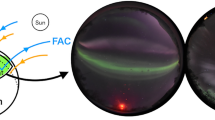Abstract
Voyager images of Saturn's moon, Iapetus1,2, confirm deductions made from Earth-based observations dating back to 1671 of a very dark leading hemisphere and a very bright trailing hemisphere3–5. Figure 1 displays contours of surface albedo from three Voyager images. The darkest area is at the apex of orbital motion, with a pronounced (∼10×) increase in albedo towards the antapex, constituting the greatest interhemispheric albedo contrast known in the Solar System. The poles are brighter still. Figure 1 also shows that the albedo distribution resembles the calculated areal variation of the trans-saturnian impact flux6 remarkably closely. Dark areas correspond to regions with the highest calculated flux. We propose here that the dark areas contain organic chromophores produced in situ by UV irradiation of CH4-rich ice, and that the albedo pattern results from ballistic redistribution of surface material in response to the impact flux gradient. Where the impact flux is high, net ablation will cause exposure of CH4-rich darkenable ice, creating a dark surface. Where the flux is low, net accumulation of non-darkenable icy regolith that has lost CH4 through repeated impact volatilization and evaporation, will create a bright surface.
Similar content being viewed by others
References
Smith, B. A. et al. Science 212, 163–191 (1981).
Smith, B. A. et al. Science 215, 504–537 (1982).
Cassini, J. D. Phil. Trans. R. Soc. 8, 51–78 (1671).
Widorn, Th. Der Lichtwechsel des Saturn Satelliten Japetus im Jahre 1949, Osterr. akad. Wissenschaften Abt. IIa 159, 186–199 (1950).
Morrison, D., Jones, T. J., Cruikshank, D. P. & Murphy, R. E. Icarus 24, 157–171 (1975).
Cook, A. F. & Franklin, F. A. Icarus 13, 282–291 (1970).
Cruikshank, D. P. et al. Icarus 53, 90–104 (1983).
Soter, S. Pap. at IAU planet. Satellite Conf., Cornell University, Ithaca (1974).
Pollack, J. B., Grossman, A. S., Moore, R. & Graboske, H. C. Icarus 29, 35–48 (1976).
Lebofsky, L. A. Icarus 25, 205–217 (1975).
Gault, D. E., Horz, F., Brownlee, D. E. & Hartung, J. B. Proc. 5th Lunar Sci. Conf, 2365–2386 (1974).
Gault, D. E. & Heitowit, E. D. Proc. 6th Hypervelocity Impact Symp. 2, 419–456 (1963).
Breslau, D. J. geophys. Res. 75, 3987–3999 (1970).
O'Keefe, J. D. & Ahrens, T. J. Proc. 7th Lunar planet. Sci. Conf., 3007–3026 (1976).
Housen, K. R., Wilkening, L. L., Chapman, C. R. & Greenberg, R. Icarus 39, 317–351 (1979).
Squyres, S. W. & Sagan, C. Proc. 14th Lunar planet. Sci. Conf., 739–740 (1983).
Khare, B. N. & Sagan, C. in Molecules in the Galactic Environment (eds Gordon, M. & Snyder, L.) 399–408 (Wiley, New York, 1973).
Hagen, W., Allamondola, L. J. & Greenberg, J. M. Astrophys. Space Sci. 65, 215–240 (1979).
Greenberg, J. M. in Comets (ed. Wilkening, L.) 131–163 (University of Arizona Press, 1982).
Khare, B. N., Sagan, C., Zumberge, J. E., Sklarew, D. S. & Nagy, B. Icarus 48, 290–297 (1981).
Bar–Nun, A., Bar-Nun, N., Bauer, S. H. & Sagan, C. Science 168, 470–473 (1970).
Duxbury, T. C. Pap. at. Int. Colloq. on the Saturn System, Tucson (1982).
Andersson, L. E. thesis Indiana Univ. (1974).
Brown, R. H., Cruikshank, D. P. & Morrison, D. Nature 300, 423–425 (1982).
Author information
Authors and Affiliations
Rights and permissions
About this article
Cite this article
Squyres, S., Sagan, C. Albedo asymmetry of Iapetus. Nature 303, 782–785 (1983). https://doi.org/10.1038/303782a0
Received:
Accepted:
Issue Date:
DOI: https://doi.org/10.1038/303782a0
- Springer Nature Limited
This article is cited by
-
Spitzer’s Solar System studies of asteroids, planets and the zodiacal cloud
Nature Astronomy (2020)
-
Cassini Imaging Science: Instrument Characteristics And Anticipated Scientific Investigations At Saturn
Space Science Reviews (2004)
-
Application of ion irradiation experiments to planetary surfaces in the Outer Solar System
Earth, Moon, and Planets (1992)
-
Cometary collisions and the dark material on Iapetus
Earth, Moon, and Planets (1989)





